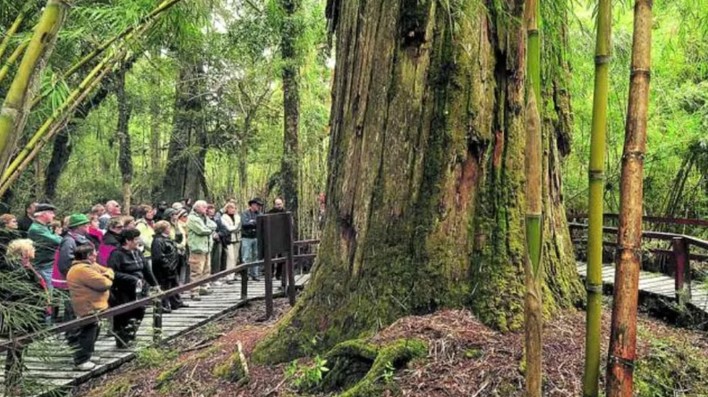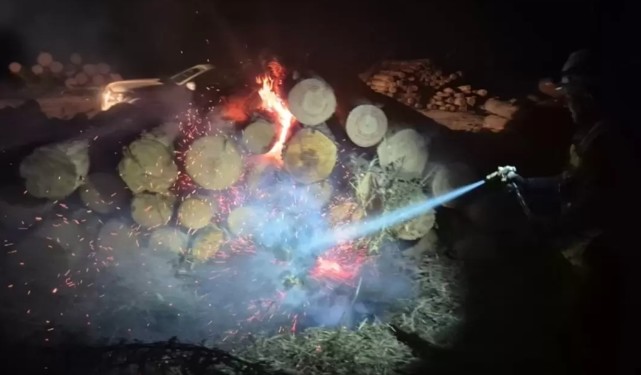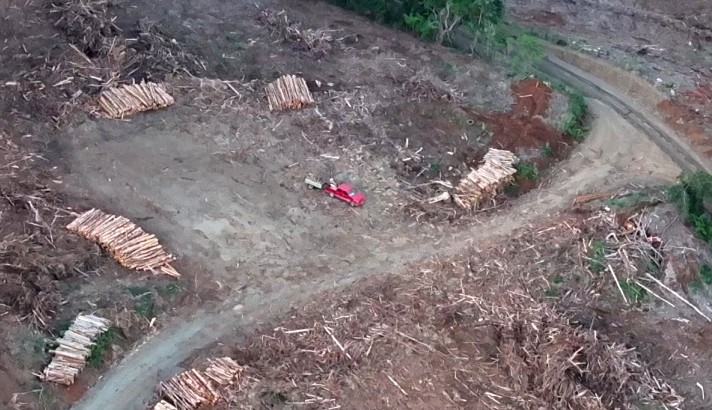"Grandfather Alerce," the 2,600-Year-Old Giant Guarding the Secrets of the Patagonian Forest, Born Before America
A magnanimous witness to history. Proud and solitary; revered and sacred. It is called *lahuán* (alerce in Mapuche), and those who grew up near it claim its branches whisper the forest’s secret history when the wind blows strong, and that within its trunk—gnarled, deep, almost wounded by the centuries—dwells a memory so ancient it does not belong to humans. Grandfather Alerce has witnessed over 2,620 winters: it was born when the world was more forest than border, before Christianity and long before Argentine history.
It stands 57 meters tall, and within its core (2.80 meters in diameter), it holds the distant echoes of the May Revolution, the Conquest of the Desert, even the traces of those who walked the ever-transforming continent. The Grandfather belongs to one of the planet’s longest-living species, *Fitzroya cupressoides*, and its presence is a reminder of human fragility before nature’s majesty. It simply stands, needing no audience to exist, rising in the depths of Los Alerces National Park in Chubut, one of the wettest and greenest regions of southern Argentina.
There, among old man’s beard, cypresses, coihues, lengas, and arrayanes, it remains a sentinel of time. Like all wise beings, it knows the forest’s secrets and keeps them silent. For the Mapuche and Tehuelche peoples, it is a forest spirit, a sacred being guarding the land and linking the living with those who are gone.
No one planted it. No one saw it sprout. Yet, it bears the mark of all that unfolded around it: a slender sapling when Rome’s history began, a young tree when Teotihuacán’s pyramids were unimagined and the word *America* did not exist. Every June 28, World Tree Day is celebrated—a chance to remember that trees hold memory and that planting, caring for, and respecting them means safeguarding history and the future.
Reaching it is not easy. Perhaps why it still lives. It stands deep in Los Alerces National Park, among damp slopes, lakes, and a forest frozen in time. Grandfather Alerce thrives in the heart of the Alerzal Milenario, a restricted-access area reachable only by sailing Lake Menéndez and hiking through coihues, cypresses, and native plants clinging to the soaked earth.
When Spanish colonizer Simón de Alcazaba y Sotomayor first skirted the coasts of modern-day Chubut in 1535, sent by Spain’s monarchs, the Grandfather was already a mature giant, over two thousand years old... Though unseen by those who might harm it, it remained hidden, shielded by the persistent damp of the Andean-Patagonian forest, where rain falls over 4,000 millimeters yearly, and the soil breathes an undying green.
There, life moves with solemn slowness. Its species, *Fitzroya cupressoides*, grows barely a millimeter per year but can live millennia. Its reddish wood, resistant to rot, was coveted for centuries—houses, roofs, railroad ties. Many fell. Not it. Perhaps because those who knew it hid it from others, or because it was far from everything, or because it knew how to hide. Or because the forest defended it.
Only in 1926 was its existence officially documented: Tucumán botanist Miguel Lillo, passing through on a scientific expedition, encountered this imposing tree. Fascinated by its size and suspected antiquity, he urged its protection. Decades later, that recommendation became foundational for the national park that now shelters it.
And so, Grandfather Alerce remains, proud and silent. Cloaked in moss, surrounded by radales and vines entwined in green twilight. In its shadows move the pudú, the huiña cat, and the huemul—still surviving there as a National Natural Monument. The Cisne River and Lake Menéndez carve through the landscape with cold, deep waters, and from their shores, everything seems held in an ancestral balance.
This region is part of the Andino Norpatagónica Biosphere Reserve and was declared a UNESCO World Heritage Site in 2017, recognizing its ecological and cultural value. This international status reinforces its protection and obliges the Argentine state to conserve the area.
A Legend Rooted in Time
For the Mapuche and Tehuelche peoples, alerces were not merely trees. They were guardian spirits, ancestors who chose to root themselves to protect the world from stillness. Each *lahuán* was a keeper of natural balance, and the oldest, like the Grandfather, were seen as silent sages, hearing the murmur of centuries.
According to Mapuche oral tradition, ancestors communicated with trees through the wind. The forest’s sounds were messages. Those who listened—not with ears but with the soul—could understand what the earth needed. Felling them, then, was more than destroying nature. It was severing a sacred bond.
Grandfather Alerce, by age, size, and symbolism, has become a near-totemic figure. Protected by law and part of UNESCO’s 2017 World Heritage designation—over 180,000 hectares of Andean-Patagonian forest preserved, free from direct human intervention. No roads or invasive infrastructure, just a minimal trail allowing respectful visitors.
Around it, no crowds or noise. Only occasional walkers circling it silently, leaving stones, wishes, whispers. Some embrace it. Some weep beside it... For the Grandfather is history, living memory. A presence confronting humans with their finitude and fragility. A mirror of what still stands and what can yet be saved.
The Great Grandfather and Methuselah, the Other Sages
Beyond the Andes, in Chile’s Los Ríos region, another ancient being defies time. The Great Grandfather, estimated at over 5,000 years by ecologist Jonathan Barichivich, could be the planet’s oldest tree, rivaling Methuselah, a bristlecone pine (*Pinus longaeva*) growing at 3,000 meters in California’s White Mountains.
The Great Grandfather is also a Patagonian alerce, like Chubut’s. Its twisted, wounded trunk spans over four meters. It grows in Alerce Costero National Park, in a corner of humid rainforest, rooted since before Mesopotamian civilizations, before pyramids, before nearly everything.
Unlike Argentina’s Grandfather, the Great Grandfather’s age couldn’t be fully measured with traditional drills—its core is deteriorated. Barichivich used non-invasive methods and statistical models to estimate its longevity. Though not yet peer-reviewed, the study suggests this tree may have sprouted over five millennia ago, before writing existed.
So far, the oldest scientifically confirmed tree is Methuselah, aged 4,850 years by ring count. Its exact location is kept secret. Though neither large nor striking, its compact trunk and twisted crown endure the northern hemisphere’s harshest winds—as if longevity demands not beauty, but patience.
Tree Day: The Language of the Earth
Standing before a tree that lived 2,000, 4,000, or 5,000 years is to see time blur. Clocks and calendars fade—only bark layers remain, in dense silences, rings telling wordless stories. Each is a living archive, a natural library without scripts. But above all, they are teachers: showing how to resist, adapt without surrender, endure without losing soul.
Science studies them, measures their ages, preserves their data. Indigenous communities still honor them, protect them, speak to them softly. To safeguard them, World Tree Day was established on June 28, 1969, by the World Forestry Congress in Rome under the UN’s Food and Agriculture Organization (FAO).
Since then, its commemoration highlights trees as pillars of life on Earth: purifying air, conserving soil, protecting biodiversity, mitigating climate change. Because some trees still remember what we were—and what we might become again.
Source:Infobae

















